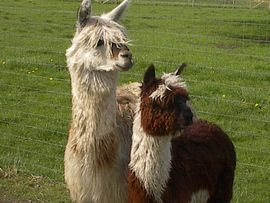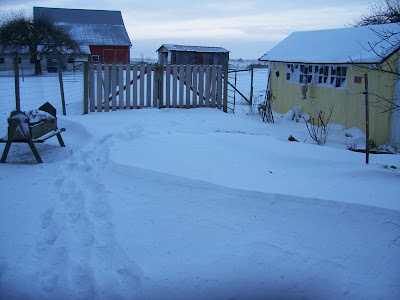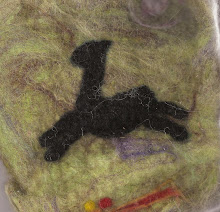 I took prenatal and birthing classes for alpacas. I had my birthing kit all packed and ready to go. But nothing prepared me for the birth of Mister Goodbar.
I took prenatal and birthing classes for alpacas. I had my birthing kit all packed and ready to go. But nothing prepared me for the birth of Mister Goodbar.I went out to the barn at about 7 AM and found Baby Ruth lying on her side with a baby's head sticking out. You are also supposed to see two legs, or at least the feet. Nope. So, I lubed up and went in to explore, so to speak. I was hoping the legs were just caught up at the pelvis, which is common, but no luck for me. The legs were facing backwards toward the rear of the cria. First rule of thumb is to push the head back into the uterus, enabling you to reposition the baby. Baby Ruth had clamped down so tightly around his head, it was impossible to accomplish. I would love to have called the vet, but I knew that I would lose either the mother, the baby, or both, if this little one was not born NOW. So, I broke all the rules. I manipulated those legs forward using shear strength and faith, muttering prayers the entire time. As you can see by the picture, I was successful in bringing the handsome little guy into the world alive.
Once I had him on the ground and breathing, I called the vet to come check out Baby Ruth. I wanted to make sure I had not damaged the uterus. Poor Baby, she was incontinent for 48 hours after that battle, but boy, did she love her baby!! Unfortunately, she has never been able to conceive again. The vet didn't find any damage at the time, but she did develop scar tissue.
Sigh.
Baby Ruth was a very special Alpaca. She is named for my mother. She must have known that, because she was always my protector when someone else was in the field with me. Whenever we gave tours, or had visitors, she would place herself between me and them. She like the attention tremendously, but no one but Alan was allowed to get next to me.
She would perform a trick that she discovered and taught herself to do. If a man was wearing a baseball cap, she would reach up and take it off his head and drop it on the ground. Then, she would pick it up again by the bill, and flip it back to the owner. We were astounded the first time she did that. She also loved to untie shoes. Anyone who had tie shoes would soon find themselves tripping over their shoelaces.
Baby finally got to be too much of a pest and a liability. In order to "protect" me, she started biting those who got too close. We finally had to face the fact that she needed to find a new home. I placed her with a wonderful woman who has had llamas for years, and she is doing very well there. But, I still get teared up and emotional whenever someone asks about her. I miss her terribly, and visiting her is too hard.
Anyhow, the gist of this post is that when you only have yourself to draw on in a difficult situation, it's amazing what you can accomplish.















